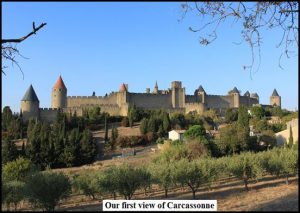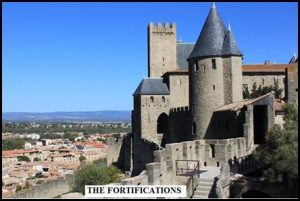By Carl Cerco-February 2017
When you first view the turrets and towers and walls of Carcassonne, you can’t believe they are real. Or else maybe they are a Disneyland fabrication? Yes, Carcassonne is real. It’s a perfectly reconstructed medieval fortress located in the Languedoc region of southwest France.
 The story of Carcassonne begins in different places for different people. For the true historian, Carcassonne was settled by the Romans in the 2nd century BC. The city reached its zenith in the 13th century when it guarded the route between present-day France and Spain. The trading routes changed and the city fell into decline and disuse. Perhaps for most, the story begins in the 19th century when the city was re-discovered by Eugène Viollet-le-Duc. Viollet-le-Duc was an architect who made a career out of restoring Gothic monuments. Vézelay, Notre-Dame, and Mont Saint-Michel are among his other restorations. When he encountered Carcassonne, it was a fallen-down military encampment. When he was finished, it was Disneyland.
The story of Carcassonne begins in different places for different people. For the true historian, Carcassonne was settled by the Romans in the 2nd century BC. The city reached its zenith in the 13th century when it guarded the route between present-day France and Spain. The trading routes changed and the city fell into decline and disuse. Perhaps for most, the story begins in the 19th century when the city was re-discovered by Eugène Viollet-le-Duc. Viollet-le-Duc was an architect who made a career out of restoring Gothic monuments. Vézelay, Notre-Dame, and Mont Saint-Michel are among his other restorations. When he encountered Carcassonne, it was a fallen-down military encampment. When he was finished, it was Disneyland.
For me, you can’t tell the story of Carcassonne without telling the story of the Cathars. The Cathars were a medieval heretical sect which flourished in Languedoc. The king of France and the Pope joined forces in a crusade to expel the heretics. Eventually, 12,000 Cathars were driven from the city completely naked. (Diversion – The Cathars were the same sect as the Albigeois mentioned by the Singing Nun in Dominique)
I first heard of Carcassonne when I was ten years old. I read a travel book written for children by a real-life Indiana Jones type who travelled the world in the 1930’s. I have wanted to visit ever since. Last October my dream of 50 years came true. We flew to Toulouse, rented a car, and headed off to Cathar country. We splurged and took a hotel room right in the old city. Carcassonne has been a tourist destination for a long time. The Hôtel de la Cité was built in 1907. We enjoyed dining in the garden while tourists walking the city walls gaped at us. Another splurge. The hotel restaurant, La Barbacane, has a Michelin star. So we signed up for a six-course tasting menu with wine pairings. Some of the courses were a little strange. You haven’t lived until you’ve tasted duck foie gras with smoked eel but they don’t hand out those stars for conventional cooking. In fact, my favorite dish in the Languedoc region was cassoulet. It’s a combination of beans, duck confit, and sausage, topped with bread crumbs and baked in the oven.
took a hotel room right in the old city. Carcassonne has been a tourist destination for a long time. The Hôtel de la Cité was built in 1907. We enjoyed dining in the garden while tourists walking the city walls gaped at us. Another splurge. The hotel restaurant, La Barbacane, has a Michelin star. So we signed up for a six-course tasting menu with wine pairings. Some of the courses were a little strange. You haven’t lived until you’ve tasted duck foie gras with smoked eel but they don’t hand out those stars for conventional cooking. In fact, my favorite dish in the Languedoc region was cassoulet. It’s a combination of beans, duck confit, and sausage, topped with bread crumbs and baked in the oven.
The two must-sees in Carcassonne are the Basilique Saint-Nazaire and the Château Comtal. Viollet-le-Duc had a way with restoring cathedrals. It was common for him to add some flourishes that were not present in the originals. You can be sure the Basilique Saint-Nazaire does not lack for gargoyles and stained glass. I’ve seen a lot of castles but none like the Château Comtal. It’s inside the city walls and formed a last refuge or keep against assault. The Château truly is a perfect restoration. In particular, visitors can see fortifications and architectural features made of wood and natural materials which have long since decayed away from structures of similar age.
Vehicular traffic is restricted in Carcassonne. Small delivery vans make their way at night and hotel shuttles take visitors to the parking lot outside the walls. Otherwise no traffic. Still, the city is one of the most popular tourist sites in France. I noted two  torture museums, a haunted house, cheeseburgers, and a kebob stand. Perhaps it’s no coincidence that these are all in one quarter of the city which you can avoid if you choose.
torture museums, a haunted house, cheeseburgers, and a kebob stand. Perhaps it’s no coincidence that these are all in one quarter of the city which you can avoid if you choose.
We stayed in Carcassonne four days and made several day trips outside the city. Depending on your tastes, you can go southeast, towards the Mediterranean, or west, towards the Atlantic. We’ve been to the Mediterranean coast of France so we headed inland, probably the direction most tourists would not choose. Carolyn satisfied her heart’s desire by taking us on a pilgrimage to Lourdes. But that’s a tale for another day. We’ll wrap up this story with a recommendation not to omit Carcassonne and the Languedoc when you plan your next visit to France.
*Name as inscribed on the UNESCO World Heritage List
